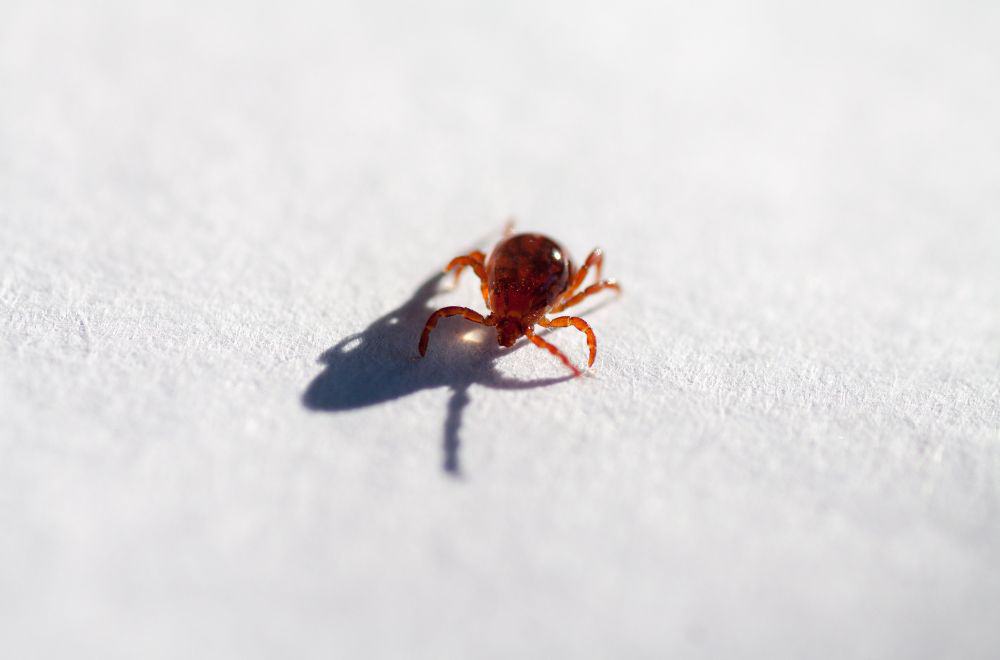Are you worried about chiggers in the house? Are you looking for the best way to get rid of chiggers once and for all?
Chiggers may not be harmful to humans and may not destroy property, but these bugs can be a nuisance if they infest your home or yard. Their bites can cause intense itchiness and blisters, making you very uncomfortable.
The truth is, getting rid of chiggers is not as easy as spraying insecticides. The small size of these critters makes it difficult to trace their habitat and curb their population.
But, on the upside, there are steps you can take to alleviate a chigger infestation, protect yourself from bites, and prevent chiggers from entering your house in the future.
Read on for everything you need to know about chiggers and tips on getting rid of these tiny bugs.
What Are Chiggers?
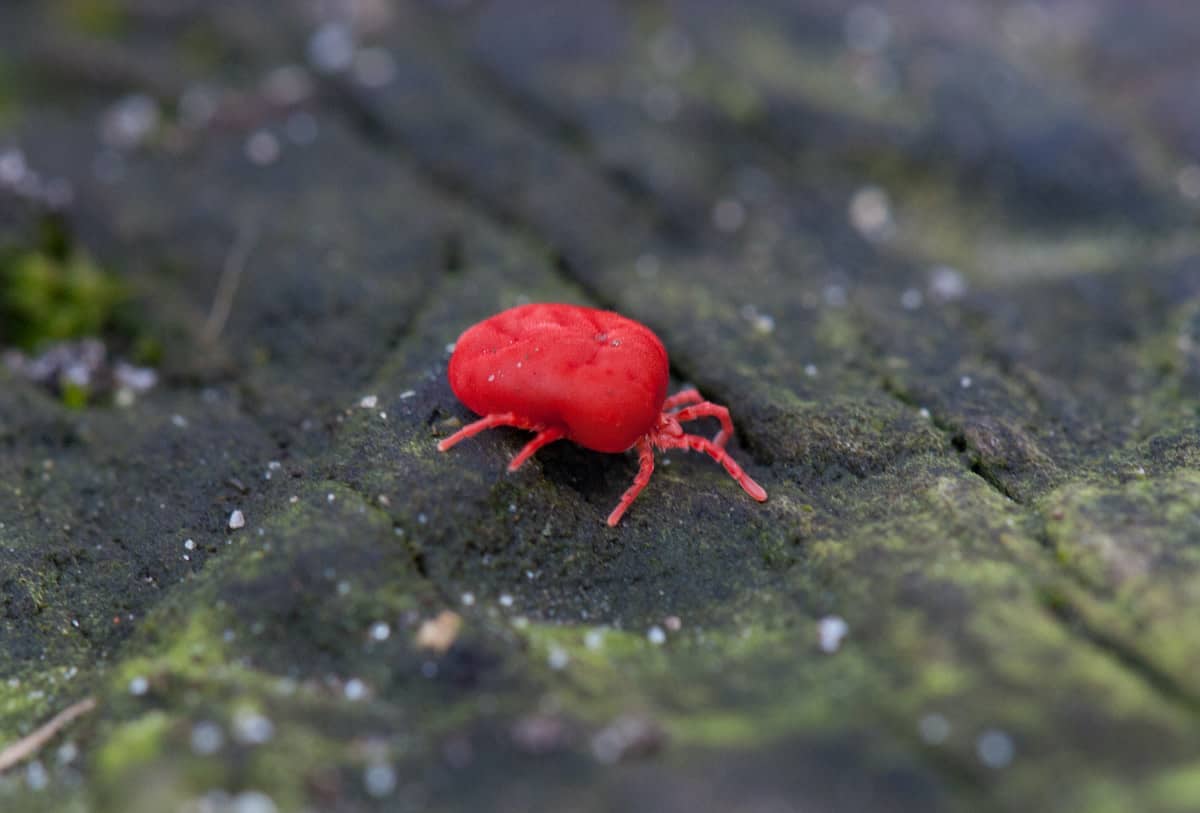
Image Credit: masterclass
Chiggers are also known as harvest lice, harvest mites, and chigger mites. Many species exist in the United States, but the Trombicula splendens and Trombicula alfreddugesi are the most common.
In the nymph stage, these bugs vary in color from red to orange and take on a bright red color as adults. While chigger larvae can be up to 0.25mm long with six legs, adults grow up to about 1 mm long with eight legs.
The life cycle of chigger mites comprises four stages: the egg, larvae, nymph, and adult. Adult male mites deposit small sperm, scientifically known as spermatophores. When the females come along, they insert the sperm into their genital pores. Fertilization of the eggs takes two weeks, after which the female adult lays the eggs on the soil, and after some time, the eggs hatch into larvae.
The larvae hang out on the soil and ground-level vegetation, waiting for a host on which to feed. At this stage, the mite is parasitic but eventually develops into a nymph and an adult. The entire cycle takes between 2 to 3 months.
Chigger mite larvae feed on the skin cells of snakes, birds, insects, and humans. Contrary to popular belief, these bugs do not feed on blood. Rather, the larvae burrow into your skin and secrete a chemical that helps to break down and digest your skin cells. The larvae then feed on the liquid consisting of skin cells.
When the mite’s mouthparts penetrate the skin, the skin hardens and forms a tube that holds the mouthparts until feeding is complete or if you scratch off the mite. If left on the host’s skin, chigger mites feed for a few days before falling off to the ground and proceeding to the nymph stage.
As mentioned, larvae are the only ones feeding on the host skin cells. Nymphs and adults, on the other hand, feed on small insects and other bugs in the soil.
Where Do Chigger Mites Live?
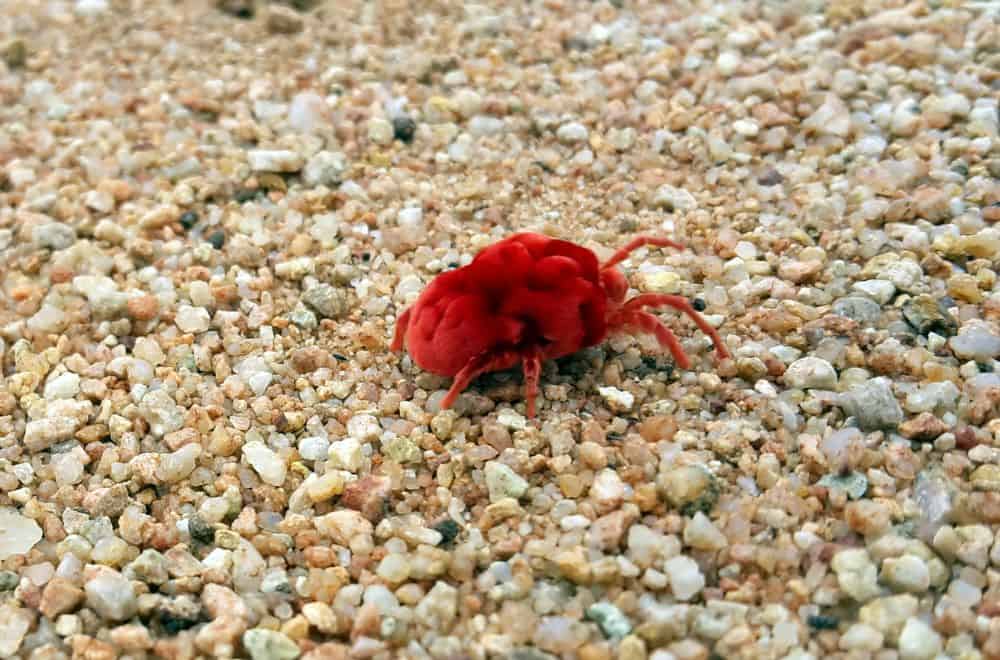
Chiggers are found everywhere in the U.S., but they are more common in the Midwestern and southeastern states, the Mississippi River valley regions, and the Great lakes area.
These tiny bugs prefer living in areas with thick vegetation, tall grasses, and unirrigated soil where they can easily latch onto their host. Chiggers are generally more dominant in rural areas than in busy urban areas. But you can still encounter a chigger infestation in the city.
Pets are a favorite host for chigger mites. When infested with these bugs, your furry friends will show symptoms such as itching and muscle twitching.
Keep in mind that your pet cannot give you chiggers and vice versa. If you and your cat or doggy have a chigger infestation, it is probably because you were outdoors in an area with a significant chigger population.
How Do Chigger Mites Enter the House?
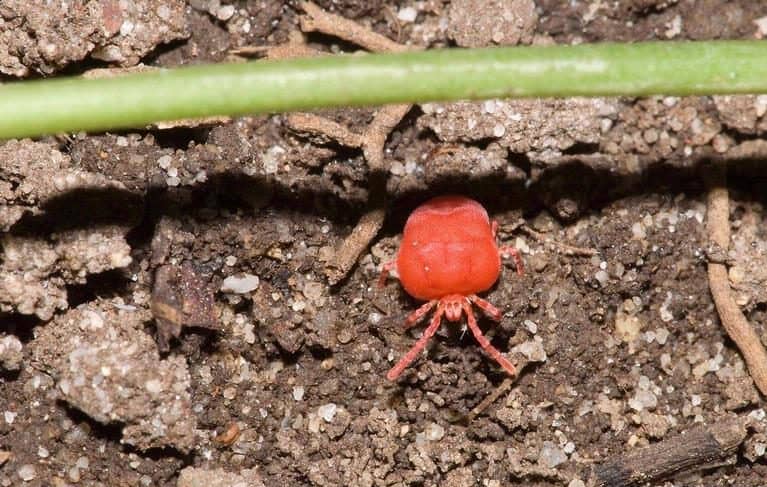
Image Credit: aces.edu
If you are dealing with a chigger infestation, you are probably wondering how these bugs got into the house in the first place.
You keep the home reasonably clean, and your furry friends are well taken care of and hygienic. You also take good care of yourself, and your hygiene is admirable.
So, why would chiggers infest your home?
Chigger mites have nothing to do with hygiene. Having these critters in your home does not mean you are dirty or disorganized. On the contrary, chiggers will invade your home if the conditions are right.
These bugs need shade, moisture, and some food. They will survive and even flourish where these three things are available.
Chiggers’ primary habitat is overgrown yards, lawns, woody areas, and gardens and flowerbeds with thick vegetation. If you or your pet are out in any of these areas where chiggers live, you will likely carry them to your house, where the mites will spread everything from your clothes to closets, carpets, rugs, and even furniture crevices and bedding.
If you are worried about an infestation, think back to the most recent time you were outdoors, whether in your lawn or garden, park, a woody area, or a heavily vegetated area—that’s where you picked up the mites and brought the larvae into your home.
When chigger mites latch onto the skin of a suitable host, such as a human or pet, it feeds on skin cells and eventually falls off the skin landing on carpets, floor rugs, curtains, and bedding.
Since chiggers live outdoors, your immediate surroundings can also attract these mites. Chiggers in the house can come from an overgrown lawn, a nearby swamp, an overgrown bush, or a garden thick with vegetation.
Chigger Bites: What They Are and What You Can Do If You Get One
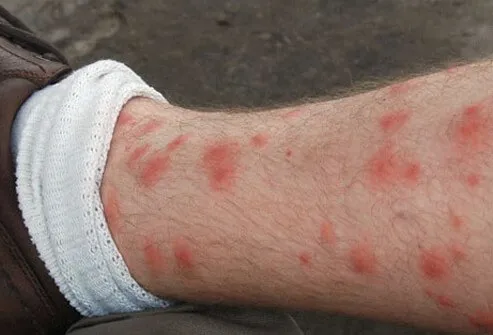
Image Credit: tsmp
Chiggers are so tiny it can be difficult to see them with the naked eye. The only way you will probably know that you have a chiggers infestation is when you start itching and develop visible marks from scratching due to a bite from these bugs.
When the larva land on the skin, it injects a digestive enzyme that breaks down and digests dead skin cells. The skin cells form a small tunnel or straw, enabling the mite to suck the digested skin tissues.
Chigger mite bits are typically intense the first day or two, with itchiness decreasing gradually over a few days.
These pests are indiscriminate and will bite anyone/anything that is a suitable host. You and your pets can land a bite from the chiggers larva, transferring this bug to the house.
Their favorite part of the body is anywhere your skin and clothes are in close contact, such as around the ankles, bra lines, waistband, wrist band, and even the groin area—these are where chiggers bite.
Are Chigger Bites Serious?
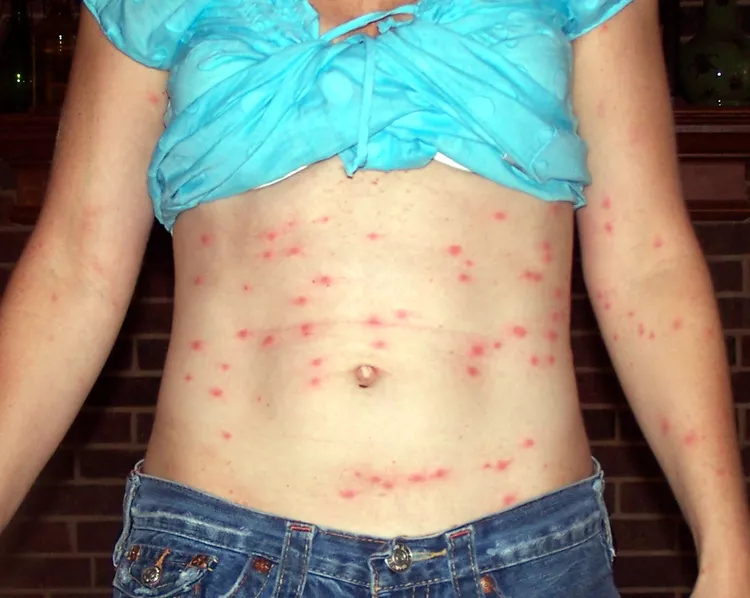
Image Credit: health
Chigger mites are most active during summer and early spring when vegetation is at its peak. According to Cleveland Clinic, since most people do not report when chigger bites bite them, the exact prevalence of these bites and mites is unknown.
Once bitten, it can take three to five days to notice chigger bites, manifesting as intense itching at the bite spot.
Here are the tale-tell signs of a chigger mite bite:
- A wavy line of red spots on your skin
- Bites appear in areas where your clothes and skin are in close contact
- Intense itch and an angry rush
Generally, chigger bites are non-fatal and do cause a serious reaction. The intense itch can be uncomfortable but usually resolves in a few days. In most cases, this is the only serious symptom of a chigger bite.
That said, severe itching can break the skin, resulting in a secondary infection with symptoms such as swelling, reddening, and pus in the affected area.
How To Treat Chigger Bites
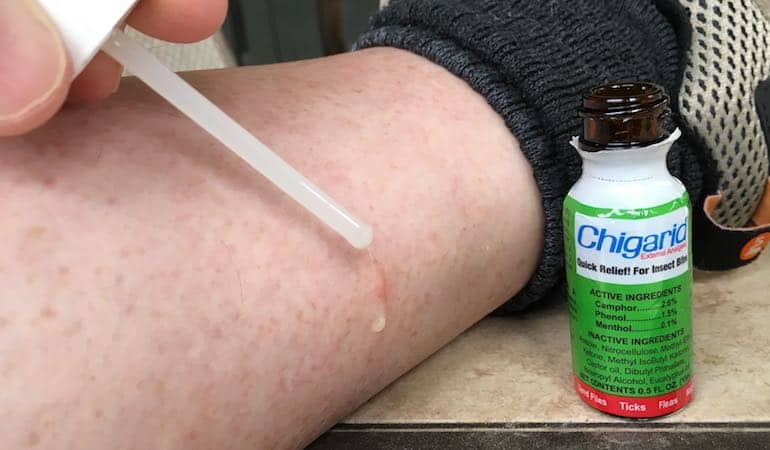
Image Credit: gameandfishmag
The itchiness of chigger bites resolves itself after a few days. The goal of treatment is to minimize the discomfort and avert the effects of a secondary infection.
There are several treatment options. These include:
- Applying a cold compress.
- Cooling the infected area with water and soap to keep the skin clean and alleviate a full-blown infection.
- Using antibiotic lotion such as calamine to cool the itch
- Taking permethrin or other physician-recommended anti-parasite medicine
- Taking antihistamines such as Benadryl
Your doctor may prescribe antibiotics in case the itch gives way to a secondary infection. Alternatively, you can treat chigger bites at home using over-the-counter creams to fight against itchiness. This, combined with antihistamine, can treat chigger bites at home and reduce skin irritation.
Prevention is better than cure. So, take steps to minimize your risk of getting chigger mites. For example, you can:
Wear long-sleeved shorts, long pants, and long socks outdoors to avoid exposing your skin.
Spray insecticide on clothing before heading out; this will help repel bug bites when you venture out.
Minimize the time spent around wet areas with tall grass and overgrown vegetation, especially during the summer when chiggers are the most active.
How To Get Rid of Chiggers In The House
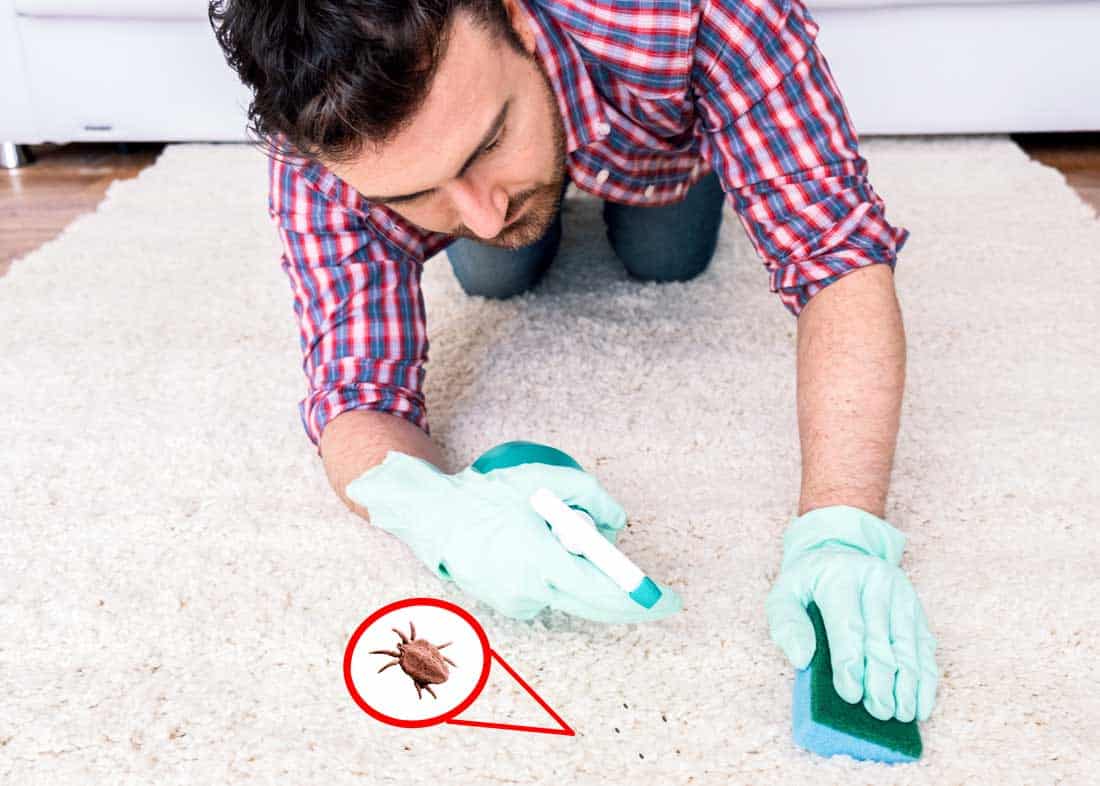
Image Credit: thebuginator
Now that you know how to identify chigger bites and the steps you can take to alleviate the symptoms, let us look at the best ways to get rid of chiggers in the house.
Unlike termites, chiggers are not destructive, so you do not have to worry about damage to your home. Chiggers also do not spread in the house in the same way as bedbugs, lice, and other bugs.
Because they do not hook themselves on the skin or lay eggs, chiggers fall off the skin very fast, so even if you bring some into the house, you will likely not have a large population that has infested your home.
That said, even a few chiggers in the house can be a nuisance, and the itching can make life unbearable for you and your pets. If you suspect you have chiggers inside the house, consider calling in a professional pest control service to eliminate these bugs.
The cost of a professional exterminator will depend on factors such as your location, the size of your home, and the extent of the infestation. Request a quote from a local extermination service for the exact cost of getting rid of chiggers in the house. Generally, expect to pay $400 to $600 or slightly more for expert chigger mite removal services.
Of course, you can also go the DIY and get rid of chiggers in the house using natural methods, prevent future infestations, and minimize the risk of chigger bites.
Cut off the source of food
In addition to human hosts, chiggers will latch onto rodents, insects, birds, and pets moving around in vegetation-rich areas. A significant population of these hosts means a ready food source for the mites. Minimize the population of hosts in your garden or yard to starve off chiggers.
Keep your landscape in tip-top condition
Avoid leaving your immediate environment in shambles, which will give chiggers a comfortable abode. Keep your grass cut, prune weeds regularly, and care for your garden as often as possible.
Wear protective clothing
If you live in areas prone to bugs, take precautions and wear protective clothing outdoors. Long pants, socks, and long-sleeved shirts can prevent bites but remember to keep your outdoor outfits loose. Tight clothing around the ankles, waistband, wristband, and knees actually attracts chigger bites to your skin.
FAQS
Can chiggers live in the bed?
No, chiggers cannot live in the bed because they need to latch onto the warm body of their host for at least three days for the larvae to complete feeding and transform into a nymph and eventually an adult. An empty bed does not provide the right environment for chiggers to live in and thrive.
What kills chiggers instantly?
Use diatomaceous earth to kill chiggers immediately. This crystallized powder kills bugs through dehydration by cutting critters with the crystals’ sharp edges. The small incisions cause chigger mites to leak bodily fluid, leading to dehydration and, eventually, death.
